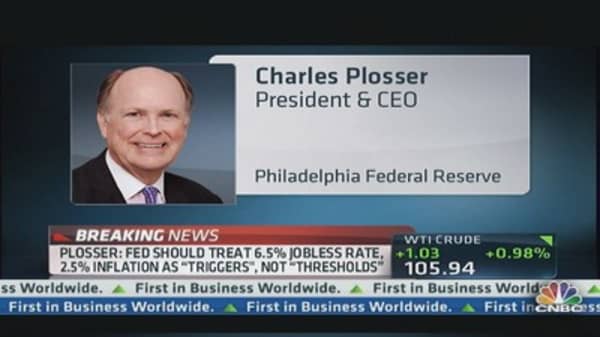Having grown by only 2.2 percent in 2012, banks' consumer lending in May was increasing by almost 5 percent year on year. In case you are wondering, the past sluggishness in the banks' core business was not a result of the weak loan demand. No, nonbank lending to consumers soared 9 percent last year, and was growing at a rate of 8 percent in the 12 months to May.
Clearly, the Fed helped the banks to rebuild their balance sheets and to gradually turn on the formidable machine of household financing, which directly fuels three-quarters of the American economy (private consumption and residential investment).
And - in case you are still asking – what is that Fed-enabled American contribution to the world economy mentioned in the first paragraph? That is what the U.S. buys more than it sells to the rest of the world – also known as the trade deficit.
(Read More: 'Debunking' a Fed Myth About Stocks)
Here again, the Fed-fueled U.S. economy gets no credit. All sorts of analysts and international organizations are whining about America's anemic economy, while praising the dynamism of emerging markets and their contribution to global growth.
What contribution is that? Emerging markets are currently selling $400 billion more than they are buying from the rest of the world. And that is what people call the engine of global growth? These countries are, in fact, living off the rest of the world.
Far from being the engine, they are, along with Germany (with a whopping trade surplus of 7 percent of GDP), a big drag on the world economy. In the first four months of this year, these "dynamic economies" were taking $334 billion out of America's aggregate demand. Adding Germany, the cut goes up to $400 billion.
That is what gets Donald Trump screaming:" They are eating our lunch!"
Plenty of time for orderly adjustment
So, give some kudos to the Fed-driven U.S. economy. And pay no attention to the nonsense of America's alleged abuse of the dollar's position as the key currency in the international monetary system. The world needs a widely used and recognized transaction currency underpinned by an appropriate financial infrastructure. That is what the dollar is and will remain for the foreseeable future. The world also needs a reliable store of value. That is what the Fed is providing – and must continue to provide – by running a currency based on a stable and noninflationary U.S. economy.
Can you take that to the bank? I believe you can. Here is why.
(Read More: So much for the 'Bernanke put': Traders fume at dovish Fed)
The integrity of the U.S. currency is implausibly put in doubt by people who believe that the Fed will (a) allow major inflationary flare-ups, (b) crash the financial markets by an inept withdrawal of its monetary stimulus, or (c) create a runaway financial crisis by a combination of these two scenarios.
It is true that the Fed is facing an unprecedented situation because it had to deal with uniquely difficult problems of the Great Recession and the biggest financial upheaval since the 1930s. The Fed is well aware of these difficulties. It would, therefore, be arrogant (and ignorant) in the extreme to say that the Fed is unprepared and incapable of unwinding its easy credit stance in a gradual and relatively orderly manner.
As always, the key to this process will be inflation expectations. They will be driven by the strength of economic activity and cost and price pressures in labor and product markets. Activity indicators will continue to set the tone to daily bond and equity trades, but wages and prices will either support or reverse the trading bets.
Wages are of particular importance because unit labor costs (wage increases minus productivity gains) put a floor below any particular inflation rate. In the first quarter of this year, these costs were running at an annual rate of 0.6 percent – roughly stable around the 0.7 percent average since the beginning of 2012 and reflecting the rising underemployment rate of 14.3 percent.
(Read More: Fed Speak Has Some Expecting QE End in December)
All this explains why the Fed apparently believes that it has plenty of time to "normalize" its bloated $3.2 trillion balance sheet. Indeed, the Fed knows that the economy would have to grow for a few quarters well above its potential growth rate of about 3 percent to create labor demand conditions that would begin to generate inflationary wage pressures.
We are very far from that, but investors would be naïve to think that easy credit conditions the Fed has in mind mean zero interest rates plus some amounts of asset purchases over the next year and a half. Assuming a well-anchored inflation rate of about 2 percent, easy credit conditions would still prevail even if the federal funds rate were gradually raised to 3 percent (from 0.10 percent at the moment).
That is most probably the interest rate trajectory the Fed will follow as it begins to move toward monetary policies that would support demand and employment without endangering longer-term price stability. Exactly the scenario equity market investors would want to see.
Michael Ivanovitch is president of MSI Global, a New York-based economic research company. He also served as a senior economist at the OECD in Paris, international economist at the Federal Reserve Bank of New York and taught economics at Columbia.





